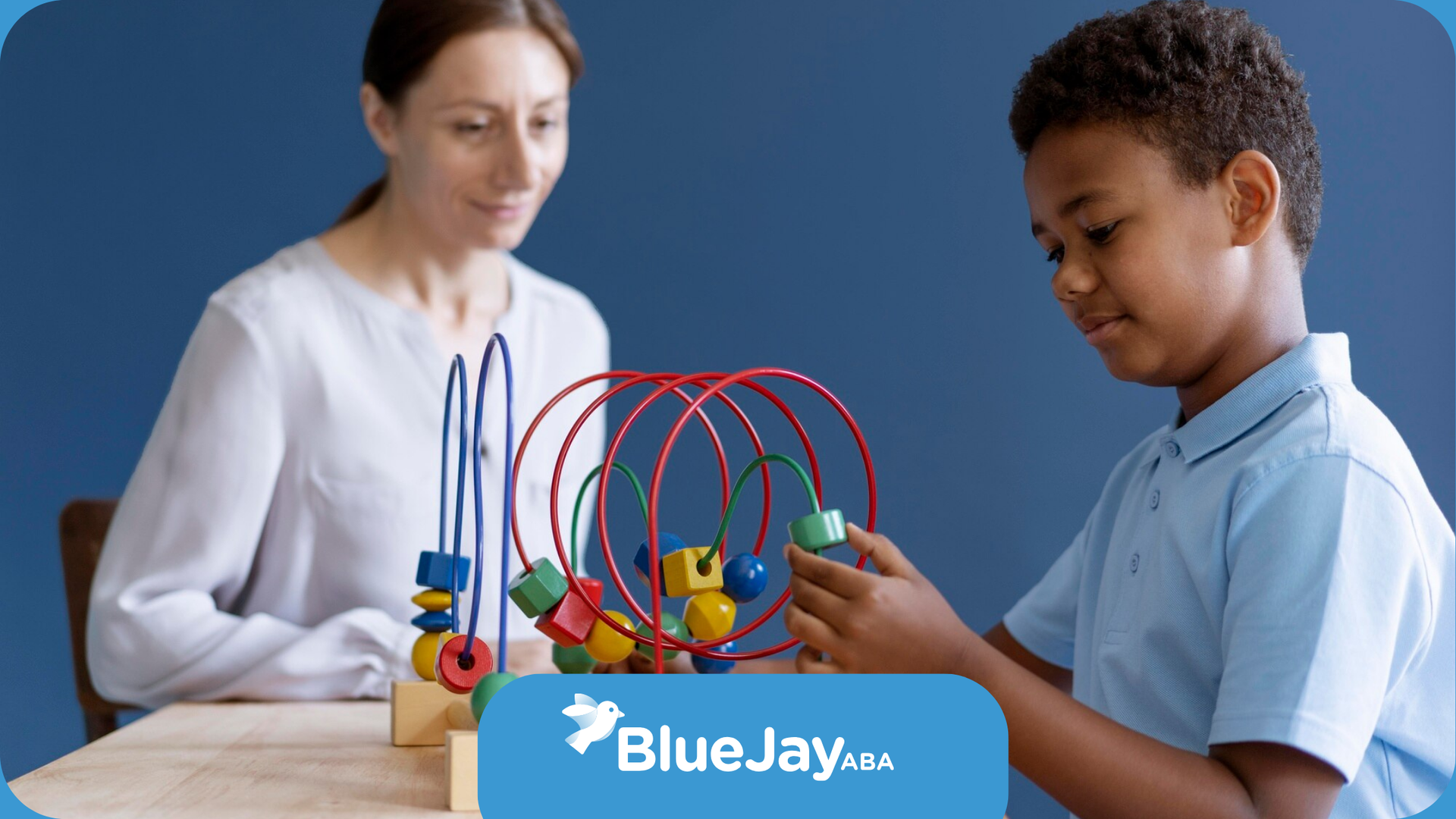Is ABA a Type of Psychology? Explained
The connection between Applied Behavior Analysis (ABA therapy) and psychology can cause discussions. ABA therapy is mainly used to help with the behavioral challenges that come with the autism spectrum. But, its ideas and ways of working are different from traditional psychology. This article hopes to explain this relationship. It will show how ABA relates to psychology while keeping its focus on behavior change.
Understanding Applied Behavior Analysis (ABA)
Applied Behavior Analysis (ABA) is a method for understanding behavior. It breaks down complicated behaviors into smaller parts. ABA uses techniques like discrete trial training and positive reinforcement. The goal is to promote positive behaviors and teach new skills. ABA therapy is often used for treating developmental disorders, such as Autism Spectrum Disorder (ASD). By using data collection and task analysis, ABA programs can help with difficult behaviors and support behavior change. ABA therapists, who are certified by the American Psychological Association, play a key role in using ABA techniques. They help individuals enhance their behavioral skills.
Defining ABA within the Psychological Framework
The American Psychological Association (APA) agrees that ABA is a practice based on evidence. It shows how effective ABA is in treating behavioral challenges. But calling ABA just a "type" of psychology does not tell the whole story. ABA is a unique field based on behaviorism.
Traditional psychology often looks inside ourselves. It studies our thoughts, feelings, and inner states. In contrast, ABA only looks at behaviors we can see and how the environment affects them. Because of this focus, behavior analysts can create plans to change specific behaviors.
ABA programs usually have a team of experts. This includes board-certified behavior analysts (BCBAs) who create and oversee treatment plans and registered behavior technicians (RBTs) who carry out these plans. This teamwork ensures that care is detailed and meets each person's needs.
The Core Principles of ABA and Their Psychological Roots
ABA is based on key ideas that come from operant conditioning, a basic part of behavioral psychology. One key idea is positive reinforcement. This means when a person shows good behavior, they get a reward. This makes it more likely they will do that behavior again. For instance, if a child gets praise for finishing a task, they are more likely to do the same task again later.
Another important idea is task analysis. This means taking complex behaviors and breaking them into smaller, simpler steps. This way, people can learn at their own speed. They first master one part of a skill before going on to the next part.
These ideas, although they come from psychology, are very important in ABA’s method for changing behavior. By systematically using these principles, ABA workers aim to create lasting and positive changes in behavior.
The Intersection of ABA and Psychology
ABA and psychology are different in how they work, but they connect a lot, especially in mental health care. Knowing their history and shared ideas shows us how they come together to help people with behavior and development issues.
Looking at how ABA uses ideas from psychology shows how linked these fields are. This shows that ABA and psychology work well together, with the same aim of bettering lives through methods backed by evidence.
Historical Context: The Origins of ABA in Psychological Theory
ABA comes from the field of behavioral psychology. Important people, like B.F. Skinner did key studies on operant conditioning. This research helped create behavior modification techniques that are now part of ABA.
In the middle of the 20th century, researchers started using these behavioral ideas to help people with developmental disorders, especially autism. This led to ABA becoming its area of study. Its goal is to improve the lives of those with autism and other developmental disabilities through tailored interventions.
Over the years, ABA has improved and adapted its methods. It relies on progress in behavioral psychology and also fields like education and special education. This blend of research and practice keeps ABA leading in behavior therapy and intervention.
How ABA Borrows from Psychological Practices
ABA focuses on observable behaviors, but it also knows that feelings like motivation and attention are important for shaping behavior. These ideas, studied in psychology, help create effective ABA techniques. For example, knowing what motivates a child can help in making good reinforcement plans.
ABA professionals often use ideas from social learning theory too. This part of psychology highlights how people learn by watching and copying others. You can see this in action with tools like video modeling and social stories. These methods help people learn communication skills and social skills by watching and imitating.
By using selected ideas from psychology, ABA builds a complete way to understand and change behavior. It pays attention to both inner feelings and external influences.
Differentiation Between ABA and Traditional Psychology
ABA and traditional psychology have some goals in common, but they are very different. The main differences come from how they study behavior and what they believe about it.
Looking closely at these differences shows us what each approach does well and where it falls short. This makes it clear that ABA is not just part of psychology. It is a field with different rules and methods.
Methodological Differences That Set ABA Apart
One important difference is in how each field does its research. Psychology usually depends on self-reporting, interviews, and set assessments to get data. On the other hand, ABA focuses on watching and measuring behaviors directly. This method helps gather exact data that leads to tailored and effective treatments.
ABA also uses special methods like discrete trial training (DTT) and task analysis. These methods break large skills down into smaller, easy steps. They focus on practice, rewards, and tracking progress by using data, which supports ABA’s goal of making behavior change measurable.
This focus on data helps therapists see how well the treatments work. They can make changes as needed to keep the treatment in line with what the person requires and how they are doing.
Outcome-Oriented Approaches in ABA vs. Theoretical Approaches in Psychology
ABA interventions focus on clear and measurable goals that help change behavior positively. Traditional psychology looks at deeper psychological processes and often does not emphasize direct, observable behaviors.
ABA aims to give people the skills they need to succeed in their everyday lives. They use methods like reinforcement systems and functional communication training. These tools help individuals control their actions and handle tough situations.
This focus on results makes ABA perfect for dealing with behavioral issues and skill gaps. It provides practical solutions based on proven methods of learning and changing behavior.
ABA's Role Within the Broader Scope of Mental Health Care
ABA affects mental health in many ways. It not only works on its own but also combines well with other therapy types. This approach understands how behavior, thoughts, and feelings work together for people who need mental health help.
Mental health workers see the importance of teamwork. They increasingly understand that using ABA ideas and methods can improve treatment plans. This helps make treatment more complete and thorough.
Integrating ABA with Other Psychological Therapies
In many mental health places, ABA therapists work together with psychologists, psychiatrists, and other therapists to give all-around care. For instance, ABA methods can help with traditional talk therapy by offering people useful ways to deal with anxiety or anger.
Also, ABA ideas can be used in family therapy sessions. This helps families create steady plans for dealing with challenging behaviors and improving positive interactions. This teamwork recognizes that behavior often comes from a mix of personal, family, and environmental factors.
When ABA's focus on specific behaviors is combined with ideas from other psychological methods, mental health professionals can build better and more complete treatment plans for various challenges.
Case Studies: Successful Integration of ABA in Mental Health Settings
Many case studies show how helpful it is to use ABA in mental health settings. For instance, research has proven that ABA can lower challenging behaviors linked to anxiety and depression in kids and teens.
In one study, researchers combined Pivotal Response Training (PRT), which is a play-based ABA approach, with cognitive-behavioral therapy (CBT) to help kids with social anxiety. The results showed big improvements in the children's social skills, communication, and anxiety levels.
| Intervention | Target Area | Outcome |
|---|---|---|
| Pivotal Response Training (PRT) | Increasing social initiations and play skills | Improved social interactions and communication |
| Cognitive-behavioral therapy (CBT) | Identifying and challenging negative thoughts | Reduced anxiety and increased coping skills |
These results show how combining ABA with other therapies can create better outcomes. It helps to tackle both the behaviors and the deeper psychological issues that cause these challenges.
The Role of ABA in Educational Psychology
Educational psychology is all about understanding how people learn and teach. It works well with ABA. The methods of ABA help in changing behavior and developing skills, making them great for schools. They promote good learning results.
When teachers use ABA principles, they can build organized learning spaces. They can also make personalized plans and effective ways to address behavior. This helps meet the different needs of students, supporting their growth in learning, social skills, and emotions.
Enhancing Learning Environments Through ABA Techniques
ABA techniques give helpful tools for teachers who want to create supportive and useful learning spaces. One example is the principle of positive reinforcement. This can be done by using token systems or praise. These methods motivate students to join in academic tasks and show good classroom behavior.
Task analysis is also very useful for teaching new skills. It helps teachers break down complicated ideas or tasks into smaller steps. This makes learning easier for different students and helps them master new skills without feeling frustrated.
Additionally, ABA stresses generalization. This means that learners should be able to use their skills in various settings and situations. By using real-life examples in teaching and giving chances to practice in different places, teachers can help students carry what they learn outside the classroom.
Behavioral Interventions in Schools: A Psychological Perspective
ABA has a big impact on educational psychology. It goes beyond just learning subjects. It helps kids and teens develop important behavioral skills. Teachers use ABA methods to solve many problems. This includes helping with social interactions, improving attention and focus, and teaching them to be independent in everyday tasks.
For example, social skills training groups are based on ABA. These groups give students chances to practice talking, solving conflicts, and acting properly in social settings. This is done in a safe and organized place. The goal is to give students the right tools to handle social situations well.
Also, ABA methods can help improve fine motor skills, like handwriting. This is done through clear teaching steps, shaping skills, and giving rewards. By breaking skills into smaller parts and giving positive feedback, teachers help students gain the coordination they need for success in school.
Ethical Considerations in ABA and Psychology
Both ABA and psychology focus on ethical practice. They follow rules that protect the well-being and dignity of the people they help. However, the ethical issues in each field are different because of how they work and what they do.
To deal with these issues, we need to keep talking, think critically, and commit to high ethical standards in both areas.
Ensuring Ethical Practice in ABA Interventions
One main ethical concern in ABA therapy is making sure that treatments are tailored to each person, respectful, and aimed at building independence. This involves getting clear consent from individuals or their guardians before starting any ABA program. It also means regularly checking for any possible negative effects.
Ethical ABA practice focuses on using the least strict methods needed to create real behavior change. This means favoring positive reinforcement strategies instead of punishment. Interventions must fit the person's age, growth level, and cultural background.
Additionally, ethical ABA practitioners work closely with families, teachers, and other professionals involved in a person's life. This teamwork ensures that interventions are used correctly and consistently in different settings. This helps people learn and reach their full potential.
The Debate Over ABA in the Psychological Community
ABA is known as a helpful approach for dealing with behavior issues, especially for those with autism. However, it has received criticism from some in the psychology field. They say that ABA focuses too much on changing behavior and not enough on the emotions and thoughts behind the behavior problem.
Some people are also worried about the way ABA might be used. They fear it could be done in a forceful or controlling way, especially if it is not led by a skilled and ethical behavior analyst. It is important to recognize these concerns and have open talks about how to make sure ABA is used fairly and respectfully.
To address these worries, we need to focus on being open, working together, and constantly reviewing how we use ABA. By valuing the choice, respect, and well-being of those getting ABA support, we can keep improving the field to deal with a range of behavior problems effectively.
Current Research and Future Directions
Current research in ABA and psychology is improving how we understand behavior. It also creates new ways to help with behavioral challenges and developmental issues. New studies are looking at how technology can be used in ABA, how genetics affect behavior, and how to make ABA practices more aware of different cultures.
As this research continues, it can help create better treatments and personalized methods for helping people. It also helps us understand human behavior better. This teamwork in learning brings hope for a better future for those facing behavioral challenges and for the people who support them.
Recent Studies Highlighting the Psychological Efficacy of ABA
Recent research shows that ABA therapy is effective for mental health. Studies prove that ABA can help with problems like anxiety, depression, and social skills issues in both kids and adults.
More studies focus on how positive reinforcement and other ABA ideas can help people control their emotions better, reduce tough behaviors linked to mental health problems, and develop better ways to cope. These results make it clear that ABA therapy is important not just for changing behavior but also for growth and well-being.
Also, research on the long-term effects of ABA therapy shows lasting improvements in people's social, emotional, and daily lives. This shows how early intervention can lead to positive and long-lasting changes.
Emerging Trends in ABA and Psychology
The fields of ABA and psychology are always changing. They are using new technologies and ideas from other areas to improve their methods. For example, telehealth lets people get ABA services from far away. This helps individuals in areas where care is hard to find.
There is also more focus on using mindfulness and acceptance techniques from psychology in ABA programs. This can help people better manage their emotions and become more aware of themselves while working on behavior change.
As more people want trained professionals, the training and certification process for behavior analysts is changing too. It is putting more importance on understanding different cultures, making ethical choices, and using technology in ABA work. These changes help the field adapt to what individuals using ABA services need. They also make sure that the care provided is high-quality, ethical, and effective.
Conclusion
Applied Behavior Analysis (ABA) is an important part of psychology. It uses methods that focus on improving behavior. This makes it different from traditional practices in psychology. ABA is useful in helping with mental health and education. It aims to change behaviors in practical ways. It also works well with other therapies to help solve behavioral challenges. Rooted in strong ethical principles, ABA is gaining attention for its effectiveness. Ongoing research shows that ABA could have a bright future in psychology.
As a leading ABA provider in North Carolina, Blue Jay ABA is dedicated to providing the highest quality care for individuals with autism spectrum disorders. Our experienced team of behavior analysts offers personalized treatment plans tailored to each individual's unique needs. We believe in the power of Applied Behavior Analysis (ABA) as a proven and effective approach to improving communication, social skills, and overall quality of life for individuals with autism. Choose Blue Jay ABA for compassionate, evidence-based care that empowers individuals with autism to reach their full potential.
Frequently Asked Questions
How is ABA different from traditional psychology?
ABA therapy is different from traditional psychology. It focuses on changing specific behaviors. Rather than investigating thoughts and feelings, behavior analysts use rewards and other methods to change people's behaviors.
Can ABA be considered a psychological intervention?
ABA therapy isn’t a traditional type of psychology. However, it is a psychological intervention. ABA programs are created by behavior analysts. They focus on making positive behavior changes using proven scientific methods.
Need Assistance?
We’re Here to Help
Our expert team is ready to support your child’s development and well-being.
We are committed to offering tailored ABA therapy solutions that promote growth.
Contact us today for Professional ABA Therapy.
Related Posts
MENU
GET IN TOUCH
STAY CONNECTED
Join our newsletter and find out more
NewsletterFooter
We will get back to you as soon as possible
Please try again later








